A Brief Introduction
How would you like to hand someone a blank check? Pretty dumb, right? Well check washing is a growing problem and it essentially puts a blank check in your name in the hands of criminals that are more than willing to fill out any dollar amount to their own bank accounts. Check washing is the process of taking a check that’s already been filled out, removing the ink from a pen, then re-writing in a new dollar amount and recipient.
The purpose of this project is to show how easy it is to wash a check and to raise awareness of the best defenses against check washing. In the following pages you will see that I’ve written out eight checks out to myself and attempted to “wash” the checks in order to write in new dollar amounts. The main target of this experiment is to see what pen defends against check washing the best.
I’m going to test four separate pens to see how well (or poorly) they react against check washing. I will use each pen to write two separate checks; one check will be washed with nail polish remover, and the second check will be washed in 91% isopropyl alcohol.
Meet the Pens
The following are the pens that will be used:
 Bic Velocity Retractable Gel Pen (black). Because this is a gel pen, the ink formulation is completely different from then generic bic round stic.
Bic Velocity Retractable Gel Pen (black). Because this is a gel pen, the ink formulation is completely different from then generic bic round stic.
 Generic Bic Round Stic (black). This is by far the most common pen out there mostly because it is so cheap and so available at stores.
Generic Bic Round Stic (black). This is by far the most common pen out there mostly because it is so cheap and so available at stores.
 Sanford Expresso Extra Fine (black). I’m not sure if this is made anymore, but the pen is unique because it uses a felt tip to dispense the ink rather than a ball.
Sanford Expresso Extra Fine (black). I’m not sure if this is made anymore, but the pen is unique because it uses a felt tip to dispense the ink rather than a ball.
 Pilot Precise Rolling Ball Extra Fine (blue). I picked this pen for two reasons: it’s blue and the ink is very “wet” — meaning that the ink comes out and does not dry immediately.
Pilot Precise Rolling Ball Extra Fine (blue). I picked this pen for two reasons: it’s blue and the ink is very “wet” — meaning that the ink comes out and does not dry immediately.
Meet the Checks
Here’s what each check looks like after being written in its respective pen. Because I made two checks per pen (one for alcohol washing and one for nail polish remover washing) only one check is shown below for each pen.

Check #508 (#513 not shown)
Bic Velocity Retractable Gel Pen

Check #509 (#514 not shown)
Generic Bic Round Stic

Check #512 (#515 not shown)
Sanford Expresso Extra Fine

Check #516 (#517 not shown)
Pilot Precise Rolling Ball Extra Fine
Meet the Tools
Obviously tools are required for this project. It is important to realize how common these tools are and how easy it is for just about anyone to check wash, and it is certainly not something the government can regulate or keep tabs on.
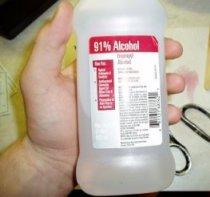

91% Isopropyl Alcohol solution and nail polish remover. The effectiveness as solvents of both these solutions were tested.

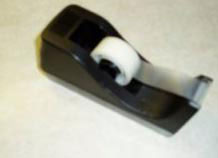


Electrical tape, scotch tape, masking tape, clear label protection tape. Many times check washers will place tape over a signature on a check in order to keep the signature from washing. I tried these four different types of tape to determine how effective they were at protecting certain areas of the checks.
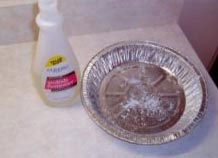
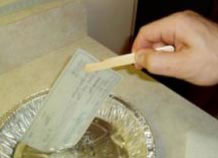

The pan above was used to be the container to hold the checks during washing, the tongs were used to remove and hold checks after being washed, and the closepins and plastic folgers can were used to store washed checks while they dried.
Procedure
The procedure is very simple. We’re going to take the checks we’ve written on and attempt to wash them. The primary observation will be which pens wash easiest and as a side experiment to find the best tape to use to cover the signature on a check during washing.
Results with Nail Polish
Alright, the first solvent I tried was Equate regular nail polish remover (salon formula). The following checks are what they looked like after one, five minute washing.
#508 (Bic Velocity Retractable Gel Pen)

I tried to use scotch tape on the front and back to protect the signature. There was a little white paint on the bottom of the tray I used, so I think that’s why the tape turned white. Overall there was no change to the ink.
#509 (Generic Bic Round Stic)
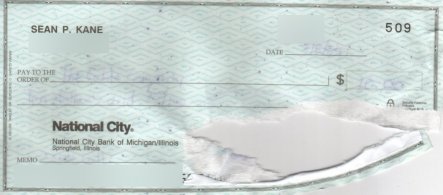
Again, I tried to use scotch tape to preserve the signature but the tape stuck to the paper and it just ended up giving the check a nice rip that completely voided it. As for the ink, it faded nicely but still was visible without looking very hard.
#512 (Sanford Expresso Extra Fine)
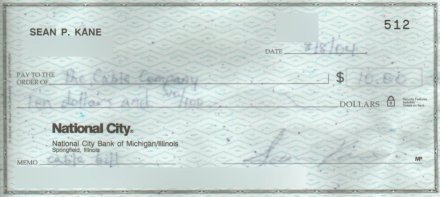

Easily the best wash yet. I didn’t even bother trying to cover up the signature because of my previous problems with the tape sticking. The ink has faded significantly, and I think if I would have left it for more than five minutes the effect would be even more pronounced.
Simply because I got such a great effect out of the nail polish remover, I decided to try soaking it in alcohol, then nail polish remover again just to see how well I could do. This is what the check looked like after two washings of nail polish remover and a washing with isopropyl alcohol.
#516 (Pilot Precise Rolling Ball Extra Fine)
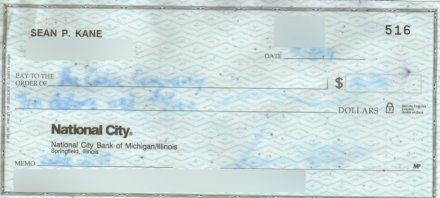
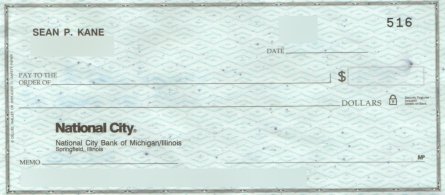
Definitely faded the ink a good amount. A plus side to the blue ink instead of the black ink is that it doesn’t stand out as well and therefore blends into the background much better.
I’m extremely proud of the second check. Just like check #512, I re-washed this check once with alcohol and once with nail polish remover. As you can see, there are very few signs that any ink existed. This is one of the best washed checks and displays how easy it is to wash a check that is written in the right pen.
Results with Alcohol
The second substance I tried was 91% Cumberland Swan isopropyl alcohol. The following checks were washed in the alcohol for five minutes each.
#513 (Bic Velocity Retractable Gel Pen)

Virtually no change in the ink. There might have been a little smearing, but nothing to be of note.
#514 (Generic Bic Round Stic)


Awesome results! The ink washed even better than it did in the nail polish remover. If I would have soaked this check a little longer I think it would have completely washed the ink away.
I washed this in alcohol and nail polish remover again just to see how good I could make it — this was a very good wash and if you look closely you can’t even really tell that the check had been washed.
#515 (Sanford Expresso Extra Fine)

The ink color itself changed from a dark black to a blurry dark brown, it did not wash away very well.
#517 (Pilot Precise Rolling Ball Extra Fine)

The ink definitely blurred, but just like the previous check it did not blur enough to say that the check was washed.
How’d the Tape Do?
Several different types of tapes were used in order to preserve the signature on the check while washing the rest of the check. Electrical tape, scotch tape, masking tape, and clear label protection tape was used. The electrical tape just fell right off the check after a minute or two. The scotch tape stuck too well and ended up ripping the paper on the check. Masking tape and clear label protection tape both performed about the same — they did not come off during washing, but after a few minutes the check’s signatures washed anyway.
Conclusion on the tape
Tape was used to preserve the signature on the checks. Regardless of the type of tape used, the liquid ended up getting under the tape anyway and washed the signature. It seems like the best way to protect the signature is to keep it out of the liquid as much as possible. If I were to do it again, I would use the clear label protection tape or masking tape and wash only parts of the check at a time. Absolutely do not use scotch tape because it will rip the paper, and do not use electrical tape because it is not adhesive enough.
Conclusion on the pens
Bic Retractable Gel Pen: This pen simply does not wash. I have always read that gel pens are the best pens to use with checks, and this experiment definitely verified that fact.
General Bic Round Stic: This pen is probably the worst pen to use on a check. The nail polish remover did an okay job on washing it, but the alcohol did a superb job of washing. When I used the nail polish remover and the alcohol together, the check was washed almost perfectly.
Sanford Expresso Extra Fine: The alcohol barely faded the ink, but the nail polish remover did a pretty good job in fading the text almost to the point where it could be completely washed. If I had left the check in the nail polish remover longer I’m confident the check would have washed nearly to completion.
Pilot Precise Rolling Ball Extra Fine: This was probably the most interesting pen to observe. The alcohol alone did an okay job, and the nail polish remover did an okay job. Together, the alcohol and the nail polish remover did an excellent (almost perfect) job of washing the ink. It seems that the components in the ink are partly soluble to the alcohol, and partly soluble to the nail polish.
How to improve this experiment
I’m assuming the nail polish remover used acetone or something similar — and I would also venture to guess that the concentration of acetone in the nail polish remover was not very strong. In order to wash the check better, a higher concentration of acetone or alcohol could be used. In addition, a longer soak period (I did five minute soakings) could be used to increase the effect of the solvent. Finally, a truly non-polar solvent (such as gasoline, toluene, ether, etc.) could be used as well.
How to protect yourself
Okay, so it’s just a little scary that it is so easy for someone to steal your own money, isn’t it? There are several ways to protect yourself from becoming a victim:
- Use a gel-based pen. I won’t say it’s impossible to wash, but I have not heard of any wash method for gel pens.
- Don’t put your checks in your mailbox…that red flag you have to put up helps check washers find you. If it is too much of a problem to not use your mailbox, make sure you don’t leave your flag up overnight.
- If you’re done with a check (it’s voided, you messed up, etc.) make sure you shred it to hell before throwing it away.
- Remember to check your bank statements right when you get them. Keep your receipts and write down transactions in your ledger so you can quickly compare your checkbook to your monthly bank statement.


